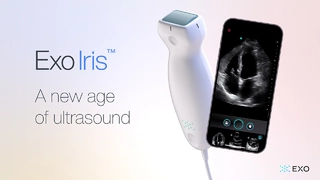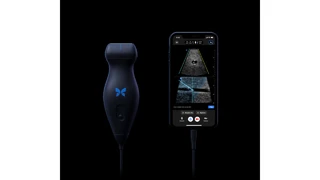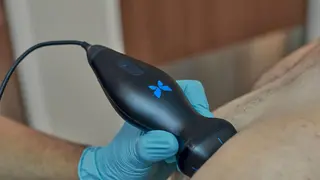MEMS Transducers
Revolution in Medical Ultrasound
Advances in MEMS technology make it possible to develop very small and inexpensive ultrasound devices that enable new diagnostic procedures and open up new markets.
Many will remember Leonard McCoy from the Star Trek series. He is a doctor on the starship Enterprise and examines his patients with his "Tricoder" diagnostic device. Not only does the Tricoder scan his patients, it also records and analyzes the data. Dr. McCoy can make an instant diagnosis.
Revolution in medical ultrasound technology - Picture gallery



Startups Butterfly Network and Exo Imaging (pronounced "echo") have something similar in mind. Their devices use ultrasound. But they look a little different from the ultrasound machines you see at the doctor's office. On the contrary, they are no bigger than an electric razor and can be taken anywhere.
Ultrasound instead of a stethoscope
The vision: Instead of the stethoscope, which has been the symbol of the medical profession for decades, doctors will carry an ultrasound probe in their pocket. But where will they see the image? All they need is a smartphone connected to the company's cloud platform via an app. What's more, these devices can be seamlessly integrated into the hospital workflow.
In the middle of last year, Exo announced a partnership with Sana clinics to pave the way for smart diagnostics in ultrasound imaging. Pilot projects at the Sana clinics in Berlin-Lichtenberg and Woltersdorf will test the cloud-based software and the associated ultrasound probe for usability and compatibility in everyday clinical practice. The goal is to enable medical staff to make real-time ultrasound diagnostic decisions and provide patients with faster care in critical situations.
Ease of use - scanning without specialists
But the vision goes even further: ultrasound-based systems will be so easy to use that doctors or specialists will no longer be needed. Patients could even scan themselves at home - the image is sent to the doctor, who can then make the final diagnosis, supported by the systems' AI.
Ultrasound for everyone
Because the systems are comparatively inexpensive - instead of $15,000 to $100,000, users pay between $2,000 and $3,500 - ultrasound scans can now penetrate regions where people previously had no access to such luxuries - and experts estimate that this is about 75 percent of the world's population.
This has apparently convinced the Bill & Melinda Gates Foundation, one of Butterfly's investors. In the spring of 2022, for example, it provided Butterfly with $5 million to equip 500 health workers in Kenya and South Africa with Butterfly's iQ3+. Midwives can use it to examine expectant mothers and their unborn children.
But that also means the potential market is huge. That attracts investor money. Butterfly, which launched in 2011, raised $400 million; after the IPO, the company was valued at $1.5 billion.
Where the euphoria comes from
Butterfly and Exo have developed highly integrated sensor arrays that sit on the front of their ultrasonic sensors. These arrays integrate not only electronic functions such as DSP, but also thousands of micromachined ultrasound transducers (MUTs) that generate and receive the sound. The system then uses the data from the reflected sound waves to calculate the ultrasound images that appear on smartphones. AI helps draw the right conclusions from the images.
CMUTs and PMUTs replace mass transducers
This has been made possible by advances in semiconductor technology, MEMS and especially MUTs, as well as advances in materials and manufacturing technology.
To understand how they work, a brief excursion into the technical details of MUTs: Micromachined ultrasonic transducers (MUTs) have been around for decades. However, in recent years they have experienced another major boom because they can be made very small and can also be used in devices that require the lowest possible power consumption. As a result, there is a good chance that they will replace traditional bulk transducers in ultrasonic transducers. They can be roughly divided into two classes, capacitive and piezoelectric MUTs, or CMUTs and PMUTs for short.
How CMUTs and PMUTs work
The basic principle is that a thin membrane is placed over a cavity. Sound pressure causes the diaphragm to vibrate. With CMUTs, the deflection of the diaphragm relative to a backplate is measured by the change in capacitance.
PMUTs, on the other hand, use the piezoelectric effect. Their diaphragm consists of a sandwich of different layers, including a thin layer of piezoelectric material. When the layer bends under sound pressure, the piezoelectric layer generates an electrical charge. Conversely, when an alternating current is applied, the diaphragm can vibrate and generate sound.
Both CMUTs and PMUTs have their specific advantages and disadvantages. While Butterfly relies on CMUTs, Exo has built its "Cello" array on the basis of PMUTs.
MEMS product development firm AMFitzgerald and MEMS Infinity, of the MEMS foundry division of Sumitomo Precision Products, also rely on piezo technology. They recently formed a strategic alliance to bring piezoelectric MEMS such as thin-film PZT MEMS to market faster and at lower cost. They see a rapidly growing market and new applications for PZT MEMS.
New Technologies - New Perspectives
"With our capacitive and piezoelectric diaphragms and cantilevers, we have the advantage of being able to adjust the frequencies via the geometry," says Dr. Chris Stöckel, Group Leader "MEMS/NEMS Technologies" at Fraunhofer ENAS. Since the MUTs are structured using lithography, they can be designed very flexibly and multiplied in a scalable manner.
This opens up new perspectives for MUTs. Until now, MUTs have mainly been of interest to companies developing MUTs for markets that require very high volumes.
One-time costs drastically reduced
Chris Stöckel is now convinced that the Fraunhofer-Gesellschaft can usher in a new era thanks to its flexible manufacturing methods: "Because we can freely design the acoustic transducers in terms of geometric, electrical and acoustic properties in a wide range of applications, it is possible to make customer-specific changes with minimal one-off costs. The reduction in one-time costs was made possible by the introduction of adaptive MUT technology platforms based on silicon wafers. These ultrasonic transducers are manufactured in parallel on wafers with high precision and reliability using lithographic production processes, which significantly reduces the unit costs for small and medium series with maximum reproducibility. In a consortium of three institutes of the Fraunhofer-Gesellschaft, we have succeeded in establishing technology platforms for CMUTs and PMUTs in the frequency range of about 20 Hz - 20 MHz for the research and development of customer-specific sound and ultrasound systems.
All indications are that PMUTs and CMUTs will lead to enormous advances in ultrasound and diagnostics.
The Next Revolution: Laser Plus Ultrasound
In the future, however, they could also pave the way for an almost revolutionary new technology that is currently making the leap from research to practical application and that will enable completely new diagnostic procedures based on a non-invasive and patient-friendly technique.
The German start-up company iThera is behind it. The Munich-based company's new method is based on the photoacoustic effect. It combines laser and ultrasound technology: A laser emits nanosecond pulses of light onto the tissue to be examined. Where the light is absorbed by the tissue, thermoelastic expansion occurs, resulting in a spherical ultrasound wave that propagates through the tissue to the detector. In short, "light in, ultrasound out". From this, the device reconstructs an image with optical contrast that can be used to detect and diagnose various disease processes. iThera calls this process multispectral optoacoustic tomography (MSOT).
Early, non-invasive, real-time diagnosis
"For the first time, anatomical, functional and molecular tissue information can be displayed in high resolution at a depth of several centimeters based on optical contrast. This enables physicians to make early, non-invasive and real-time diagnoses, for example of inflammatory, fibrotic, cardiovascular and tumor diseases," explains Christian Wiest.
However, the detectors in the devices are currently custom-made. "The development of PMUTs or CMUTs is a challenge for us because of the high one-time costs," says Christian Wiest, CEO and co-founder of iThera Medical. This does not mean that he cannot imagine using arrays based on PMUTs or CMUTs in the future. There is already a collaboration with Fraunhofer ENAS to develop PMUTs or CMUTs with integrated preamplifiers. It would be especially nice if the transducers were also translucent. "Then we could shine the lasers through them and wouldn't have to resort to side illumination," says Christian Wiest. Above all, it would be an opportunity to further reduce the cost of the devices, expand the accessible market - and open up new areas of application.
The bottom line: We may not have Leonard McCoy's tricorder yet, but PMUTs and CMUTs will take us a long way towards it.








